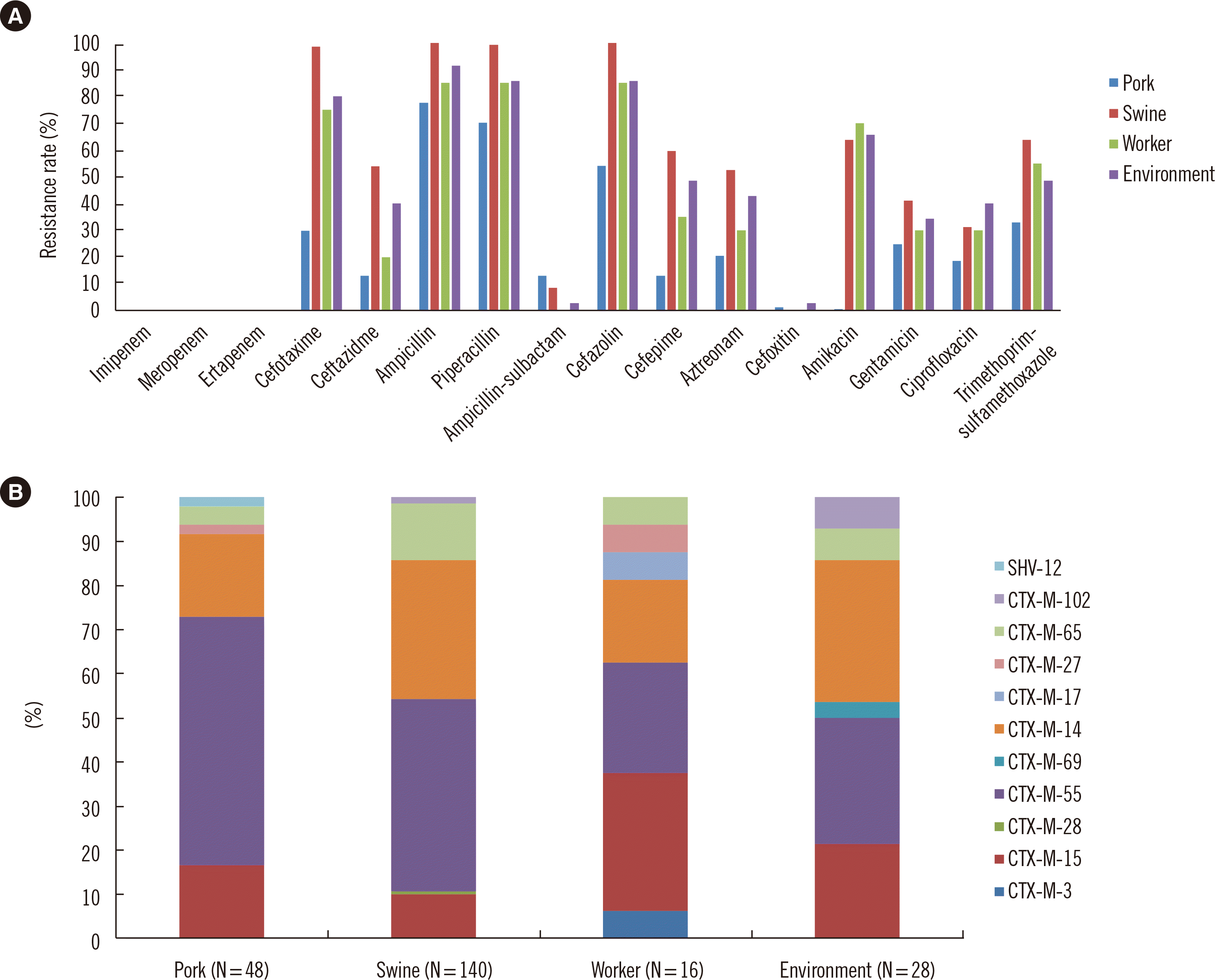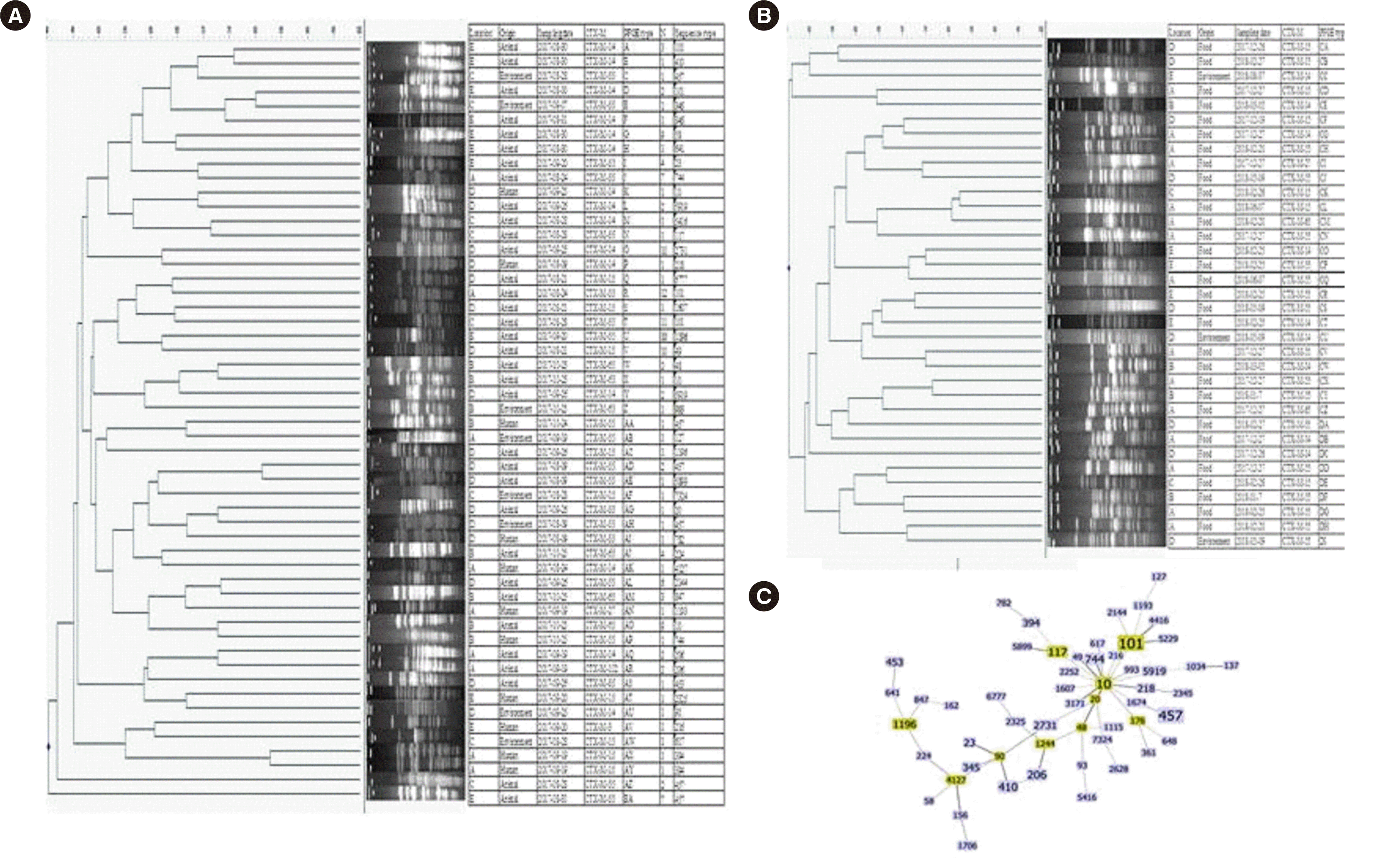1. Lee H, Yoon EJ, Kim D, Jeong SH, Won EJ, Shin JH, et al. 2018; Antimicrobial resistance of major clinical pathogens in South Korea, May 2016 to April 2017: first one-year report from Kor-GLASS. Euro Surveill. 23:1800047. DOI:
10.2807/1560-7917.ES.2018.23.42.1800047. PMID:
30352640. PMCID:
PMC6199864.

2. Powell N, Davidson I, Yelling P, Collinson A, Pollard A, Johnson L, et al. 2017; Developing a local antimicrobial resistance action plan: the Cornwall One Health Antimicrobial Resistance Group. J Antimicrob Chemother. 72:2661–5. DOI:
10.1093/jac/dkx164. PMID:
28595316. PMCID:
PMC5890714.



3. Na SH, Moon DC, Choi MJ, Oh SJ, Jung DY, Sung EJ, et al. 2019; Antimicrobial resistance and molecular characterization of extended-spectrum β-lactamase-producing
Escherichia coli isolated from ducks in South Korea. Foodborne Pathog Dis. 16:799–806. DOI:
10.1089/fpd.2019.2644. PMID:
31305137.

4. CLSI. 2017. Performance standards for antimicrobial susceptibility testing. CLSI M100. 27th ed. Clinical and Laboratory Standards Institute;Wayne, PA:
5. Ryoo NH, Kim E-C, Hong SG, Park YJ, Lee K, Bae IK, et al. 2005; Dissemination of SHV-12 and CTX-M-type extended-spectrum β-lactamases among clinical isolates of
Escherichia coli and
Klebsiella pneumoniae and emergence of GES-3 in Korea. J Antimicrob Chemother. 56:698–702. DOI:
10.1093/jac/dki324. PMID:
16141280.

6. Rojas LJ, Salim M, Cober E, Richter SS, Perez F, Salata RA, et al. 2017; Colistin resistance in carbapenem-resistant
Klebsiella pneumoniae: laboratory detection and impact on mortality. Clin Infect Dis. 64:711–8. DOI:
10.1093/cid/ciw805. PMID:
27940944. PMCID:
PMC5850634.

7. Yoon EJ, Hong JS, Yang JW, Lee KJ, Lee H, Jeong SH. 2018; Detection of mcr-1 plasmids in
Enterobacteriaceae isolates from human specimens: comparison with those in
Escherichia coli isolates from livestock in Korea. Ann Lab Med. 38:555–62. DOI:
10.3343/alm.2018.38.6.555. PMID:
30027699. PMCID:
PMC6056395.


8. Park YS, Bae IK, Kim J, Jeong SH, Hwang SS, Seo YH, et al. 2014; Risk factors and molecular epidemiology of community-onset extended-spectrum β-lactamase-producing
Escherichia coli bacteremia. Yonsei Med J. 55:467–75. DOI:
10.3349/ymj.2014.55.2.467. PMID:
24532519. PMCID:
PMC3936615.


10. Andersson DI, Hughes D. 2014; Microbiological effects of sublethal levels of antibiotics. Nat Rev Microbiol. 12:465–78. DOI:
10.1038/nrmicro3270. PMID:
24861036.


11. Manyi-Loh C, Mamphweli S, Meyer E, Okoh A. 2018; Antibiotic use in agriculture and its consequential resistance in environmental sources: potential public health implications. Molecules. 23:795. DOI:
10.3390/molecules23040795. PMID:
29601469. PMCID:
PMC6017557.


12. Rousham EK, Unicomb L, Islam MA. 2018; Human, animal and environmental contributors to antibiotic resistance in low-resource settings: integrating behavioural, epidemiological and One Health approaches. Proc Biol Sci. 285:20180332. DOI:
10.1098/rspb.2018.0332. PMID:
29643217. PMCID:
PMC5904322.

13. Lim S, Lee J, Lee H, Nam H, Moon D, Jang G, et al. 2014; Trends in antimicrobial sales for livestock and fisheries in Korea during 2003-2012. Korean J Vet Res. 54:81–6. DOI:
10.14405/kjvr.2014.54.2.81.

14. Lazarus B, Paterson DL, Mollinger JL, Rogers BA. 2015; Do human extraintestinal
Escherichia coli infections resistant to expanded-spectrum cephalosporins originate from food-producing animals? A systematic review. Clin Infect Dis. 60:439–52. DOI:
10.1093/cid/ciu785. PMID:
25301206.

15. Kim H, Kim YA, Park YS, Choi MH, Lee GI, Lee K. 2017; Risk factors and molecular features of sequence type (ST) 131 extended-spectrum β-lactamase-producing
Escherichia coli in community-onset bacteremia. Sci Rep. 7:14640. DOI:
10.1038/s41598-017-14621-4. PMID:
29116143. PMCID:
PMC5677100.



16. Kim YA, Kim JJ, Kim H, Lee K. 2017; Community-onset extended-spectrum-β-lactamase-producing
Escherichia coli sequence type 131 at two Korean community hospitals: The spread of multidrug-resistant E. coli to the community via healthcare facilities. Int J Infect Dis. 54:39–42. DOI:
10.1016/j.ijid.2016.11.010. PMID:
27865830.

17. Kim YA, Kim H, Choi MH, Seo YH, Lee H, Lee K. 2020; Whole-genome analysis of
blaCTX-M-55-carrying
Escherichia coli among pigs, farm environment, and farm workers. Ann Lab Med. 40:180–3. DOI:
10.3343/alm.2020.40.2.180. PMID:
31650737. PMCID:
PMC6822000.

18. Johnson JR, Urban C, Weissman SJ, Jorgensen JH, Lewis JS 2nd, Hansen G, et al. 2012; Molecular epidemiological analysis of
Escherichia coli sequence type ST131 (O25:H4) and
blaCTX-M-15 among extended-spectrum-β-lactamase-producing E. coli from the United States, 2000 to 2009. Antimicrob Agents Chemother. 56:2364–70. DOI:
10.1128/AAC.05824-11. PMID:
22354301. PMCID:
PMC3346636.


19. Johnson JR, Clermont O, Johnston B, Clabots C, Tchesnokova V, Sokurenko E, et al. 2014; Rapid and specific detection, molecular epidemiology, and experimental virulence of the O16 subgroup within
Escherichia coli Sequence Type 131. J Clin Microbiol. 52:1358–65. DOI:
10.1128/JCM.03502-13. PMID:
24501035. PMCID:
PMC3993632.


20. Platell JL, Johnson JR, Cobbold RN, Trott DJ. 2011; Multidrug-resistant extraintestinal pathogenic
Escherichia coli of sequence type ST131 in animals and foods. Vet Microbiol. 153:99–108. DOI:
10.1016/j.vetmic.2011.05.007. PMID:
21658865.

21. Zurfluh K, Hächler H, Nüesch-Inderbinen M, Stephan R. 2013; Characteristics of extended-spectrum β-lactamase- and carbapenemase-producing Enterobacteriaceae isolates from rivers and lakes in Switzerland. Appl Environ Microbiol. 79:3021–6. DOI:
10.1128/AEM.00054-13. PMID:
23455339. PMCID:
PMC3623138.



22. Kim YA, Qureshi ZA, Adams-Haduch JM, Park YS, Shutt KA, Doi Y. 2012; Features of infections due to
Klebsiella pneumoniae carbapenemase-producing Escherichia coli: emergence of sequence type 131. Clin Infect Dis. 55:224–31. DOI:
10.1093/cid/cis387. PMID:
22491340. PMCID:
PMC3491773.


23. Wang Y, Zhang R, Li J, Wu Z, Yin W, Schwarz S, et al. 2017; Comprehensive resistome analysis reveals the prevalence of NDM and MCR-1 in Chinese poultry production. Nat Microbiol. 2:16260. DOI:
10.1038/nmicrobiol.2016.260. PMID:
28165472.

24. Fischer J, San José M, Roschanski N, Schmoger S, Baumann B, Irrgang A, et al. 2017; Spread and persistence of VIM-1 carbapenemase-producing Enterobacteriaceae in three German swine farms in 2011 and 2012. Vet Microbiol. 200:118–23. DOI:
10.1016/j.vetmic.2016.04.026. PMID:
27234907.


25. Hong JS, Song W, Jeong SH. 2020; Molecular characteristics of NDM-5-producing
Escherichia coli from a cat and a dog in South Korea. Microb Drug Resist. 26:1005–8. DOI:
10.1089/mdr.2019.0382. PMID:
32043911.
26. Lee JY, Lim SK, Choi Y, Moon DC, Shin J, Ko KS. 2018; Whole sequences and characteristics of
mcr-1-harboring plasmids of
Escherichia coli strains isolated from livestock in South Korea. Microb Drug Resist. 24:489–92. DOI:
10.1089/mdr.2017.0369. PMID:
29485936.

27. Belaynehe KM, Shin SW, Park KY, Jang JY, Won HG, Yoon IJ, et al. 2018; Emergence of
mcr-1 and
mcr-3 variants coding for plasmid-mediated colistin resistance in
Escherichia coli isolates from food- producing animals in South Korea. Int J Infect Dis. 72:22–4. DOI:
10.1016/j.ijid.2018.05.011. PMID:
29803875.

28. Lim SK, Kang HY, Lee K, Moon DC, Lee HS, Jung SC. 2016; First detection of the
mcr-1 gene in
Escherichia coli isolated from livestock between 2013 and 2015 in South Korea. Antimicrob Agents Chemother. 60:6991–3. DOI:
10.1128/AAC.01472-16. PMID:
27572390. PMCID:
PMC5075127.








 PDF
PDF Citation
Citation Print
Print



 XML Download
XML Download